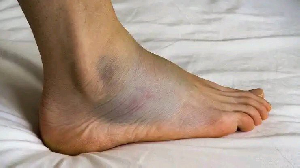
Included among the causes of swollen lower extremities are medical conditions, unhealthy behaviors, and trauma. In this article, we will discuss the most common causes of edema in the lower extremities, as well as some treatment options.
According to webmd, edema, or the accumulation of fluid in the body's tissues, is a common cause of swollen lower extremities. Medications, obesity, and pregnancy are all potential edoema triggers. It may also be indicative of more severe health conditions, such as heart or renal failure.
Another common cause of swollen legs and feet is venous insufficiency, which occurs when the vessels in the legs are unable to pump blood back to the heart. This may result in the development of edoema in the extremities. Risk factors include age, obesity, and a personal or family history of venous insufficiency.
As reported by Healthline In addition to causing swollen legs and feet, lymphatic dysfunction, in which the lymphatic system's network of capillaries and tissues is not functioning as it should, can also cause lymphedema. Consequently, edoema may develop in the lower extremities.
Edoema of the leg and foot can also be caused by injuries such as sprains and fractures. When edema and pain occur together, it may be necessary to seek medical attention.
Additionally, a poor diet and sedentary lifestyle can cause leg and foot edema. Long periods of standing or sitting may contribute to the accumulation of fluid in the legs and consequent swelling. Tight apparel or footwear could also be a factor.
Then, what can you do about the edema in your legs and feet? The following recommendations are as follows:
Keep your legs elevated. By redirecting blood and fluids back to your circulatory system, elevating your legs can help reduce edema.
Regular walking or swimming may help improve circulation and reduce edema in the legs and ankles.
Compression stockings can be worn to alleviate edema and improve blood circulation in the lower extremities.
If you must stand or sit for extended periods, get up and move around periodically.
The use of loose, comfortable apparel and footwear can help reduce swelling in the lower extremities.
Edoema of the legs and feet can be managed by maintaining a healthy, balanced diet. By decreasing sodium consumption and increasing fruit and vegetable consumption, fluid retention can be reduced.
Leg and foot edema, particularly if persistent or severe, requires medical attention. A medical professional can help determine the cause of the edema and the most effective treatment for the underlying condition.
In conclusion, numerous medical conditions, lifestyle choices, and accidents can cause distended legs and feet. Leg elevation, regular exercise, compression stockings, avoiding protracted standing or sitting, loose clothing and footwear, and a healthy diet can all aid in the control and reduction of edoema. If your edema is severe or persistent, you should see a doctor to determine the cause and receive treatment.
